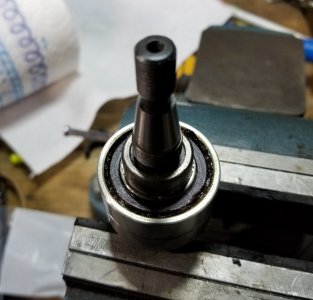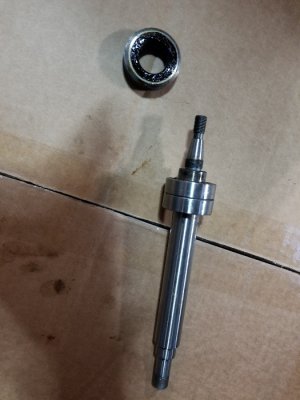- Joined
- Jun 15, 2017
- Messages
- 525
Without any pictures you not gonna get any definite answers. Having a double bearing in the front sounds like you have angular contact bearings in the front ,the rear bearing is gonna be a slip fit for expansion so the spindle doesn't bind up. I would doubt there is cosmoline in the spindle housing dried up grease or oil yes cosmoline no. The front bearing set is there a locknut holding the two bearings on the spindle? When you get some time take some detailed pictures and post it'll be the best way to get some accurate advice.
I wasn't looking for answers. Just reporting on the situation.
I don't believe there is cosmoline in the bearings. I think the grease turned into something exactly like cosmoline because of the heat from the bad bearings. It's almost as if someone melted a brown crayon in there.
Someone suggested cleaning the old bearings out and re-greasing them, but I don't think the grease would have been corrupted had the bearings been sound. I don't know, though. They appear to be sealed, so I would have to pry the seals off and put them back on. They're supposed to be cheap, so I see no reason to struggle with the old ones.
Why would there be grease on the outside of sealed bearings? I haven't seen that before. Wondering if it migrated out from inside the bearings.
I'm trying to find out what kind of bearings I have. I'm contacting the manufacturer. We'll see how that works out. If I have any trouble with the removal or installation, I'll be back.
I'm trying to find a set of sockets for castellated round nuts. I know they exist, because the nuts exist. I'm finding all kinds of names. "Spanner sockets." "Spindle sockets." "Spindle locknut sockets." Making things more complicated, most are made for automotive use, so it's not like you can look for a set from 1/2" to 1-1/2" with a 1/2" drive. You have to look for Honda, Chevy, or whatever. Also, they're extremely expensive, which makes no sense, because they're very simple to make. I would love to have a set, but it looks like it's easier to make them on demand than to find them ready to buy.
For anyone else who makes a tool for these nuts, don't make the mistake I made. Do not make an 8-pin tool. You only need 4 pins. It's much easier to make on the mill.
A company called SKF makes a bunch of tools for this type of nut.



